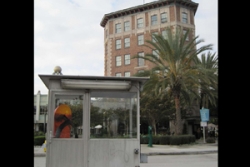
Downtown Culver City became the host of East German culture with a pop of art in recent weeks. From Oct. 19-Nov. 3, an East German Guardhouse was placed in the in front of The Culver Hotel. Many found it strange to see the guardhouse in this location. Oddly enough, many assumed that it had been there all along, leading up to Culver Studios parking lot. The interesting part is the history of this foreign piece and the stories that it has to offer the city.
The East German Guardhouse, a symbol of investigation and controlled society, has traveled to Los Angeles for the 25th Anniversary of the fall of the Berlin Wall. Since Sept. 26, the guardhouse has been a part of two-month exhibition series in Los Angeles, known as project ADN Pförtnerhaus, which will extend to Nov. 23 and follows the 12-month long exhibition series in Berlin, Germany. The East German Guardhouse, a part of the former headquarters of the General German News Service (ADN) of East Germany, made its temporary stay in Downtown Culver City, courtesy of the Wende Museum, where it will take its permanent residence.
The curator behind this symbolic art installation, Christof Zwiener, of Berlin, Germany, invited 10 artists to feature their art work inside, which has ultimately become a gallery for their pieces. So far the guardhouse has displayed such works as “Key Delivery,” a collection of almost 2,000 keys that came from one of the former GDR police barracks that belonged to every room and locker, created by German artist Sonya Schönberger.
During its stop in Culver City, the East German Guardhouse featured a large sculpted flip-flop, occupying most of the space inside by German artist Frederick Kunath. The sculpture titled “Some power, that hardly looked like power, said I’m only perfect in an empty room,” (after the lyrics of the song The Wild Kindness by David Berman), is a symbol of foreign popular culture that is housed and restrained by a structure that is embedded in political and social anxiety.
The ADN Guardhouse is connected to the state surveillance, public space, and traces associated to the Berlin Wall in Berlin. Zwiener saved the guardhouse from being destroyed in 2013, making it the last remaining monitoring station of East Germany. In the middle of his project in Germany, Zwiener was contacted by Justin Jampol, the Founder and Executive Director of the Wende Museum to create an exhibition series in Los Angeles.
Collecting items that represent the Cold War has been a personal interest and mission for Jampol. As a historian, he believes that no one would know about this era without exposing these collections to others, each having multiple stories and meanings. By looking at materials from other cultures, Jampol believes we are able to identify each unique story and their meaning through our perceptions of them. Through other’s ideas and perceptions, Jampol says people are able to learn more about ourselves.
“At the end of the day these are just things,” says Jampol. “What makes them sparkle and come to life is the fact that they are exposed and made accessible to people.”
Having made its way through several stops in Los Angeles and Culver City, project ADN Pförtnerhaus will conclude its exhibition series at the ESMoA on 208 Main St. in El Segundo from Nov. 14–23, with featured artwork by German architects Evelyn Temmel and Bernard Luthringshausen.
Soon Zwiener and his wife Schönberger will be returning to Berlin, but he is happy to be leaving the ADN Guardhouse in Culver City with the Wende Museum. He considers it a gift and feels that its presence will be much appreciated here. Zwiener believes Culver City is a great new home for the guardhouse, planted on the sand and underneath the palm trees.
“I want people to ask questions from the information that is given.” Zweiner said. “I like to work with hidden ideas and I hope that people learn from pieces like this.”
“People will get curious and ask what this is,” Schönberger adds. “They will be able to see it and sense how high the wall was and get the idea that it is a symbol of a divided city. The guardhouse reflects how we think we can build a wall in other societies, that keeps others away and tells them who can get in and who cannot. This is an object that represents how the communist society functioned and raises the question of how a democratic society functions now-a-days.”
For more information about the history and the current and past exhibitions of the ADN Guardhouse, persons interested can visit www.adn-pfoertnerhaus.de. To learn more about The Wende Museum, their collections, and upcoming events, persons interested can visit www.wendemuseum.com.












